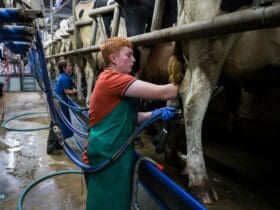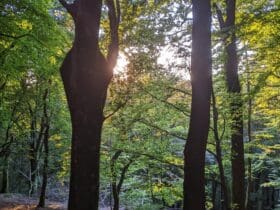A pioneering new project that involves reverting back to traditional 1940s farming methods has transformed a stretch of coastline in Wales into a haven for rare animals, birds and wildflowers – boosting numbers in some instances by more than 300 per cent.
[aoa id=”1″]
The tried and tested ‘strip field’ farming involved flower crops being planted alongside more traditional arable crops and wildflower meadows across 45 hectares (111 acres) of farmland near the spectacular Worms Head in Rhossili, South Wales, cared for by the National Trust.
And, just two years after the project started, the stretch of iconic coastline has been restored to its former glory and boasts a stunning array of rare birds such as the grasshopper warbler, common linnet and hen harriers.
Butterflies such as the small blue, grayling and wall brown butterflies have also returned to their former habitat.
[/aoa]
It is hoped this approach to farming could be used by larger, more intensive farms.
Four National Trust rangers and 80 volunteers have spent the last 12 months faithfully recreating the 12thCentury patchwork of fields on The Vile, creating 2,000 metres of new banks and new hedges which had previously been removed after the Second World War in favour of modern, intensive farming methods.
Instead of just six fields, there are now 17 which have been purposely planted with specially selected flowering crops to include 400,000 sunflowers, poppies, lavender and lupins which punctuate the crops of millet, wheat, oats, buckwheat, spelt, linseed and barley with ribbons of vibrant colour.
These crop fields are now a haven for scarce wildflowers, such as cornflower and corn marigold.
An additional 7.5 hectares (19 acres) have been left as wildflower hay meadows with grasses and flora including oxeye daisy, yarrow and bird’s-foot trefoil.
The team has also created 1 km of new pathways across The Vile to encourage visitors to see the new crops and wildlife.
The Vile is just one of many sustainable farming projects that are currently underway in England, Wales and Northern Ireland after the conservation charity announced its ambition to create 25,000 hectares of priority habitat to nurture nature back in 2015.
Alan Kearsley-Evans, Countryside Manager for the National Trust says:
“It’s fantastic to see such results in just the first year to returning to this way of farming.
“We have simply reverted to farming sustainably, like we did back in 1945, and with astounding results. It doesn’t cost us any more – in fact, in time it will save us money as we won’t need to rely on any other inputs – our method of crop rotation and harvesting actually makes the crops self-controlling.
“Every crop has been planted for a reason with wildlife the outright winner with each field benefitting a vast variety of invertebrates and birds throughout the year.
“We know that our farm is very small, but the principle of what we’re doing and the results could be applied to large intensive farms. We aim to prove in a few years, just how viable this method is and to showcase the many benefits it delivers.”
A key advantage of the strip field system (and using banks to divide fields) is to help deflect the wind that can whip across the coastline which helps not only to protect the crops but has meant that returning wildlife such as the 21 varieties of butterfly and 10 species of bumble bee can forage in the sheltered microclimate created by the restored banks.


This wind deflection also prevents any moisture from being wicked away, instead holding the moisture in the fields which helps the soil and presents perfect growing conditions for the different crops.
National Trust ranger, Mark Hipkin said:
“The combination of the crop choice and strip field farming has created a pollinators paradise.
“By planting vast amounts of sunflowers, poppies and our other crops we have attracted more pollinators and birds. In fact, this year taking a walk through the sunflower fields we’ve seen a bumble bee on nearly every sunflower head which means we’re already sustaining a huge (or dramatically increased) population of bees.
“The weather has definitely been in our favour this year as we’ve had a very productive crop and we aim to harvest next month in an old 1970’s combine harvester which is small enough to turn in the restored narrow strip fields.”
To help encourage wildlife, the team actively leave behind some of the crop. Seeds dry out and attract birds, for example, linnets are attracted to the linseed and the remaining sunflower seeds will feed overwintering birds on the coastline.
Mark continued: “What we’ve actually created is this amazing giant bird table by growing crops that will be used as bird food, while leaving some in the fields unharvested for winter birds.”
Malcolm and Ruth Ridge, two of the volunteers who have been involved in the project said: “Every minute has been worth it. It’s amazing what has been achieved.
“What had become a fairly sterile bit of ordinary countryside has been brought back to life, teeming with colour and a haven for birds, butterflies and insects of all sorts as well as small mammals and reptiles. It is also restoring an important part of our agricultural history; a working strip-field system that was common throughout Britain for centuries and has now all but disappeared.”
Next year the team is planning to rotate the crops and to also allocate a further two or three of the strip fields to lavender and to introduce bee hives to create honey.
Mark Harold, Director of Land and Nature at the conservation charity concludes: “The work we’re doing on The Vile is a fantastic example of us testing ways in which we can bring back wildlife on marginal land where we can learn how farming and nature can work together hand in hand.
“Farmers need nature and nature needs farmers to give it a helping hand, to improve soil condition, to provide more space and to cater for its needs through every season.
“Although this project may be small scale, it is certainly a great way to show other land owners and farmers what can be achieved.”








Leave a Reply
View Comments